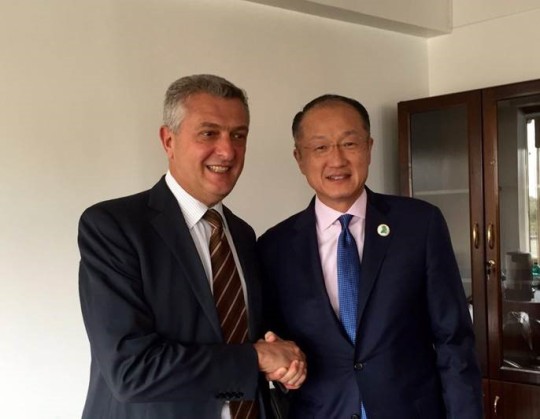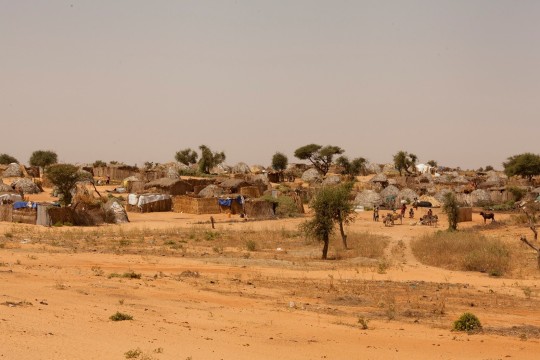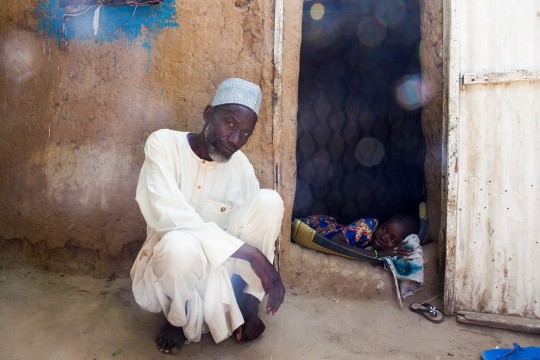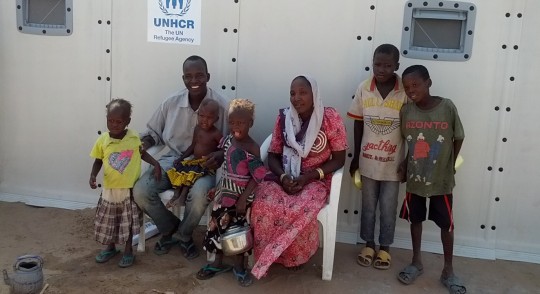UNHCR Niger
Month
 UNHCR High Commissioner Filippo Gandi and World Bank president Dr. Jim Yong Kim (Photo : Pablo Mateu)
UNHCR High Commissioner Filippo Gandi and World Bank president Dr. Jim Yong Kim (Photo : Pablo Mateu)
The World Bank Group and UNHCR have engaged in an increasing number of collaborations over the years at both country and headquarters levels - a sign of an ongoing important paradigm change in the approach toward forced displacement. Following the completion of a joint research paper, entitled “Forced Displacement by the Boko Haram Conflict in the Lake Chad Region” (http://data2.unhcr.org/en/documents/details/52535), a joint regional workshop was held in Senegal, followed by a national dialogue in Niger in November, both involving the national authorities. A World Bank Mission came to Niger at the end of January to carry out a Strategic Diagnostic on forced displacement in Niger. The Diagnostic was extended to Malian refugees and to the mixed migration situation.
Caroline Vagneron, “Senior Operations Officer for Forced Displacement, Fragility, Conflict and Violence Group” at the World Bank, led the mission in Niger.
What are your main impressions following your mission to Niger?
What the team has been impressed by during the mission was first, the fact that, for many years, Niger has shown exemplary solidarity and hospitality towards forcibly displaced people despite a difficult macroeconomic and security context. Also, the fact that the Nigerien authorities chose not to differentiate aid recipients according to their status (refugees, IDPs, returnees) but to meet the needs of the most vulnerable without distinction contributes to a peaceful coexistence between communities, especially considering the level of distress refugees, internally displaced, returnees and their hosts have gone through (women in particular). What we also noticed was how much the economic asphyxiation of the region of Diffa, due both to the economic crisis in Nigeria and to the security situation near the Lake, weighs on local institutions. Finally, as we wrapped up the mission, one important message to take home was the necessity to bridge humanitarian and development approaches to better respond to the crisis. This is something the UNHCR has embarked on already and that the WBG is fully committed to. Under the leadership of the Government of Niger, the coordination of donors and humanitarian and development partners will be essential to success.
Why are the World Bank group engaged in the issue of forced dispalcement ?
Forced displacement has emerged as an impor¬tant development challenge: extreme poverty is now increasingly concen¬trated among vulnerable groups including people who have fled conflict or violence, and their presence affects devel¬opment prospects in the communities that are hosting them. The Bank’s overall objective is to help reduce poverty among both the forc¬ibly displaced and their host communities, as part of a broader effort to achieve the Sustainable Development Goals (SDGs). The focus is on tackling the medium-term socio¬economic dimensions of forced displacement. This is complementary to, but distinct from, the rights-based protection agenda and the urgent focus on short-term crisis responses that an institution like UNCHR would pursue. The Bank’s approach focuses on helping reduce or elimi¬nate the specific vulnerabilities that affects the abil¬ity of the forcibly displaced to seize economic opportunities and to help host communities manage the shock caused by large inflows of people so that they can pursue their own poverty reduction efforts while provid¬ing an accepting environment for the forcibly displaced.
In what way does the World Bank Group intend to immerse itself in the issue of forced displacement?
The World Bank Group’s commitment to responding to forced displacement is an integral part of its development mandate, in line with the strategy adopted by the Development Committee in April 2016. In fact, during the IDA 18 negotiations, donor countries agreed to establish a regional sub-window for refugees to provide dedicated source of funding for host governments struggling to meet the needs of both refugees and their host communities. The forthcoming implementation of this regional sub-window for refugees and host communities will benefit countries hosting more than 25,000 refugees. This commitment to support refugee host countries to mitigate the shocks caused by the influx of refugees and create conditions for economic and social development for refugees and host communities; promote solutions to protracted refugee displacement and strengthen their capacity to better prepare themselves to respond to new crises should they arise. The World Bank Group can contribute a range of services to this end, from analytics to convening to financing together with other key partners and to continue to work with economic poli¬cymakers, inform policy formulation, and help strengthen institutions.
For both the World Bank Group and UNHCR, this is a new collaboration. It is important to learn to work together, focusing on the needs on the ground, and to come to clear joint perspectives, with the relevant national authorities. In your opinion, what are the aspects on which both organisations must work alone, in order to ensure the success of the project?
In terms of the operational partnership between the WBG and the UNHCR, the best results are likely to be achieved when we engage in complementary efforts for greater impact throughout the entire period of forced displacement. Our agencies have different objectives, counterparts, and instruments. We can both contribute to a comprehensive effort from the onset, learn from each other, and build syner¬gies based on our respective comparative advantages. But to do this, we will need to understand each other (and the way we work) better. We’re currently working on some joint training for both WBG and UNCHR staff, which I think will help tremendously, above and beyond the interactions we will have in the different countries we work in.

Jérôme Gence est photographe freelance. A la fin de l’année 2016, il se rendait au Niger pour suivre le parcours d’un jeune Nigérien issu de la classe populaire, symbole à lui seul de la diversité des mouvements migratoires, qui s’est exilé en Asie pour y développer progressivement un commerce florissant. Au gré de ses rencontres, la mention à « Diffa » lui a souvent été faite, à laquelle était adossé très souvent un autre mot : « Solidarité ». Il a alors traversé le pays pour mettre en image le fil conducteur de cette crise.
La chaleur est écrasante à Diffa. Il suffit simplement de faire quelques pas dans le sable de cette petite ville nigérienne pour imaginer les conditions dans lesquelles vivent plus de 300 000 personnes, réfugiées ou déplacées. C’est en arrivant sur la route nationale 1 que l’on réalise l’ampleur de la situation.

Dans ces villages sortis de nulle part, les conditions de vie sont éprouvantes. Dans leurs fuites, les personnes réfugiées ou déplacées ont tout laissé derrière elles. En manque de tout, elles se retrouvent donc exposées à de nombreuses situations de vulnérabilité. Mais au milieu de ce chaos, cette route nationale 1 emmène aussi tout droit au cœur de certains habitants de Diffa qui spontanément accueillent des familles entières de personnes réfugiées ou déplacées.
Parfois ce sont des liens familiaux ou d'amitiés qui les rapprochent, mais bien souvent ce n’est que le hasard qui comme un rendez-vous, redonne à ces familles un espoir inattendu. C’est le cas de la famille de Mr Abdoul Karim Aboubacar. Avec sa femme et ses 6 enfants, Mr Aboubacar a fui d'abord Boko Haram depuis Malam Fatori, au Nigéria, et ensuite depuis Bosso au Niger où, avec sa famille, il est resté un an. C’est en arrivant à Diffa qu’il a rencontré Abdou Harouna qui s’est proposé de l’accueillir.
Ouvrir les portes de la petite maison de Mr et Mme Harouna, c’est se réconcilier avec l’humanité. Chez eux, pas de différences entre réfugiés et famille d’accueil. Les enfants s’amusent ensemble et chacun aide comme il peut. Le plus étonnant est que la famille Harouna aurait bien des raisons de fermer ses portes à des personnes réfugiées : maigres revenus, famille déjà nombreuse à nourrir, petite maison. Malgré cela, ils ont décidé d’accueillir la famille Aboubacar et ont réussi à remettre des sourires à leurs visages. Comme elle, de nombreuses familles de Diffa illustre cet élan de solidarité dont on parle peu mais sans lequel la situation serait encore plus dramatique.
 Mme Harouna nous accueille chez elle au moment du dîner.
Mme Harouna nous accueille chez elle au moment du dîner. Elle prépare d’abord le dîner pour tous les enfants.
Elle prépare d’abord le dîner pour tous les enfants. Le regard d’une fille sur son père, Mr Aboubacar. Pour ces hommes, après avoir réussi à mettre leurs familles à l’abri, un nouveau défi reste à relever, celui de trouver du travail pour subvenir aux besoins de la famille et préserver sa dignité.
Le regard d’une fille sur son père, Mr Aboubacar. Pour ces hommes, après avoir réussi à mettre leurs familles à l’abri, un nouveau défi reste à relever, celui de trouver du travail pour subvenir aux besoins de la famille et préserver sa dignité. Dans leur fuite, la famille de Mr Aboubacar a tout laissé derrière elle : maison, outils de travail, vêtements. Il tient à nous montrer les sacs de vêtements qu’il a reçus grâce à la solidarité des habitants de Diffa.
Dans leur fuite, la famille de Mr Aboubacar a tout laissé derrière elle : maison, outils de travail, vêtements. Il tient à nous montrer les sacs de vêtements qu’il a reçus grâce à la solidarité des habitants de Diffa. Mr Aboubacar et Mr Harouna autour de quelques souvenirs. En plus des biens matériels, c’est également des souvenirs d’une vie que les familles laissent derrière elles, parfois pour longtemps : une personne réfugiée reste en moyenne 17 ans hors de son pays.
Mr Aboubacar et Mr Harouna autour de quelques souvenirs. En plus des biens matériels, c’est également des souvenirs d’une vie que les familles laissent derrière elles, parfois pour longtemps : une personne réfugiée reste en moyenne 17 ans hors de son pays.



Dans des contextes de crise humanitaire, l’attention se focalise très souvent, pour faire bref, sur « ce qui ne va pas ». Diffa n’échappe pas à cela. Pourtant, loin des clichés et du fatalisme, dans cette région, bel et bien debout après plus de 3 années extrêmement éprouvantes, les initiatives, les innovations, la vitalité intellectuelle et culturelle sont omniprésentes. L’Université de Diffa en est le parfait exemple. Malgré son existence récente, elle insuffle une dynamique ancrée dans son environnement lui permettant de jouer un rôle important dans l’accompagnement la région à se projeter dès aujourd’hui vers l’avenir.
Tisser des relations avec le monde universitaire est un élément important pour l’UNHCR. Au Niger, l’organisation collabore avec les Universités de Niamey et Tahoua, notamment pour l’accueil des élèves réfugiés maliens ou pour offrir des terrains de stage aux étudiants. Elle est en contact régulier avec l’Université d’Agadez particulièrement engagée dans les problématiques migratoires. Afin d’améliorer sa maitrise du contexte d’intervention à accompagner la dynamique en cours, l’UNHCR entend progressivement renforcer sa collaboration avec l’Université de Diffa.
Environnement, écologie, agronomie sont les principaux domaines que couvre l’Université de Diffa, mais son engagement va bien au-delà. Le Professeur Ali Mahamane est le recteur de l’Université de Diffa. Ce blog lui a donné carte blanche pour qu’il nous présente les actions menées par l’Université.
 Première promotion d’étudiants de l’Université
Première promotion d’étudiants de l’Université
L’Université de Diffa a été créée par la Loi n°2014-40 du 19 Août 2014 avec comme mission de relever les défis environnementaux et écologiques. Les responsables ont été nommés le 16 janvier 2015. L’installation de l’Université de Diffa a démarré au moment même où la secte Boko Haram attaquait la ville de Diffa le 6 Février 2015. Mais ces attaques n’ont pas empêché la poursuite des activités de l’Université dont l’un des rôles est la prise en charge des problèmes de la société. Pour que la population se sente, soutenue moralement l’Université de Diffa a organisé un atelier international de validation des curricula de ses offres de formations à Diffa les 23, 24 et 25 août 2015 en présence des éminences de 14 Universités de la Sous - Région Ouest Africaine. Ceci a permis de décrisper un tant soit peu la psychose créée par Boko Haram et montrer qu’à Diffa on peut organiser une rencontre internationale dans la quiétude.
Par la suite, les Autorités Administratives Régionales de Diffa ont posé la question de savoir : quelle pourrait être la contribution de l’Université de Diffa pour le retour de la paix dans le bassin du Lac Tchad ? Ces Autorités ont souligné qu’à leur avis, la communauté scientifique doit et peut nécessairement s’impliquer car elle peut apporter une contribution pour accompagner les succès militaires. Afin de concrétiser sa mission de service publique devant prendre en charge les préoccupations pressantes de la société, toute la communauté universitaire de Diffa a salué cette volonté des Autorités Régionales d’impliquer l’Université de Diffa dans la résolution du conflit dans le Bassin du Lac Tchad.
C’est ainsi que l’Université de Diffa a organisé du 2 au 4 Novembre 2015 à Diffa un «Colloque international sur la culture de la paix dans le Bassin du Lac Tchad ». Plus de 100 participants relevant de 19 Universités, 14 Institutions nationales et internationales et 7 ONG et Associations nationales et internationales en provenance de 11 pays (Bénin, Burkina Faso, Cameroun, Espagne, Etats Unis d’Amérique, France, Mali, Niger, Nigéria, Sénégal, Tchad) ont pris part à ce colloque.
L’objectif du colloque était d’une part de proposer des idées qui seront soutenues par les partenaires pour accompagner les populations et d’autre part de mettre en place un réseau sous régional à même d’organiser des colloques tournants sur les 4 pays (Cameroun, Niger, Nigeria et Tchad) afin de mener une réflexion permanente sur les questions de paix et de développement dans le Bassin du Lac Tchad.
Au cours du colloque, plus de 14 communications sont présentées, suivies des travaux dans trois (3) commissions, ce qui a permis de formuler vingt deux (22) recommandations, déclinées en cadre logique, adressées aux Autorités des pays membres du bassin de Lac Tchad, aux Partenaires Techniques et Financiers, aux ONG et Associations et aux Chercheurs afin que chacun joue un rôle déterminant dans l’accompagnement des populations victimes de l’extrémisme violent. Les Actes du Colloque, le Rapport Général et le Cadre Logique ont été édités grâce à un financement du PDEVII/USAID.
Pour un suivi efficace et permanent de la mise en œuvre des recommandations, nous avons mis en place une Cellule Paix et Développement à l’Université de Diffa. Cette cellule évoluera à terme vers un Institut International pour la Paix, le Dialoque et le Développement (2IP2D) dont l’argumentaire a été remis à la hiérarchie.
A la suite du colloque de novembre 2015, l’Université de Diffa a organisé un « Symposium international sur la sécurité dans le Bassin du Lac Tchad » les 14 et 15 mai 2016 à Diffa, symposium qui a vu la participation des chefs traditionnels et des Commandements des détachements militaires des 4 pays du Bassin du Lac Tchad (Cameroun, Niger, Nigéria, Tchad).
L’Université de Diffa a bénéficié d‘un renforcement de capacité suite à un séjour aux USA du 16 au 21 mai 2016 du Recteur dans le cadre du International Visitor Programme (#IVLP) pour rencontrer plusieurs Institutions en charge d’étudier et de prévenir l’extrémisme violent. Aussi, l’Université de Diffa a participé activement à diverses rencontres sur la Paix, la Sécurité et le Développement au Niger et dans les pays de la sous Région : (1) Colloque d’inauguration des activités du Centre National d’Etudes Stratégiques et de Sécurité (CNESS) à Niamey, les 25 et 26 juillet 2016 ; (2) Sommet Régional de la jeunesse sur la lutte contre l’extrémisme violent à Maiduguri, Nigeria, du 28 au 30 novembre 2016 ; (3) Colloque Régional sur la Radicalisation et l’Extrémisme Violent au Sahel organisée par la Mission des Nations Unies pour le Mali et le Sahel (MISAHEL) et le G5 Sahel à Niamey du 8 au 10 décembre 2016 ; (4) Workshop sur l’engagement des acteurs de la société civile dans les programmes de réhabilitation et de réinsertion des délinquants extrémistes violents et le retour des combattants terroristes étrangers, les 13 et 14 décembre 2016 à Lagos, Nigéria.
L’Université de Diffa collabore avec les Autorités Régionales, les Organisations de la Société Civile, les ONG et Associations qui interviennent sur le terrain dans la Région de Diffa. Les activités se rapportent au renforcement des capacités des communautés villageoises en agro-écologie, en agroforesterie, des séances de sensibilisation sur la Régénération Naturelle Assistée (RNA), sur la protection de l’environnement, la gestion rationnelle et la surveillance des ressources pastorales et hydriques, appui à la restauration et le renforcement des moyens d’existence et à la relance des activités économiques, la gestion de conflits et le renforcement de la cohésion sociale.
 Production de plants en pépinières par les étudiants de l’Université de Diffa
Production de plants en pépinières par les étudiants de l’Université de Diffa
Ambitions et projets futurs pour l’Université de Diffa : (1) améliorer la connexion internet compte tenu de notre situation géographique pour un échange permanent avec le reste du pays et du monde, (2) assurer une meilleure visibilité et le rayonnement de l’Université de Diffa à travers des animations scientifiques permanentes, des formations de qualité, des publications scientifiques de haute facture, (3) exécuter le Plan stratégique que nous avons élaboré pour l’Université jusqu’à l’horizon 2025 avec l’aide de nos partenaires, (4) mettre en place un Incubateur qui consiste en des fermes expérimentales qui contribueront au développement de l’entreprenariat des jeunes et même de formation de courtes durées à l’intention des déscolarisés et des non scolarisés qui vont maitriser parfaitement les techniques agricoles. Ces jeunes à leur tour vont disséminer, par la pratique, ces différentes techniques et contribuer ainsi à résorber le désœuvrement des jeunes qui ne seront plus tentés par des aventures aux lendemains incertains (exode rural, migrations clandestines, trafic et consommation des stupéfiants, enrôlement par des groupes extrémistes, etc.). La réussite de ces jeunes contribuera à booster le taux de scolarisation et dans un bref avenir le développement socioéconomique de la Région toute entière ; (5) comme on l’a fait en son temps avec le colloque sur la culture de la paix dans le bassin du Lac Tchad, nous comptons organiser un Symposium international sur la déradicalisation et la réinsertion des repentis à Diffa dans les tous prochains mois pour accompagner la nouvelle dynamique amorcée par les plus Hautes Autorités de notre Pays.
Professeur Ali Mahamane
Recteur de l’Université de Diffa http://www.univ-diffa.ne
 Better Shelters in Maine Soroa, Diffa Region
Better Shelters in Maine Soroa, Diffa Region
In the region of Diffa, UNHCR have been providing emergency shelter assistance to vulnerable refugees and displaced persons since the first refugees crossed the border fleeing Boko Haram violence in Northern Nigeria in 2013. In 2016 alone, over 65,000 people in the Diffa region benefitted from UNHCR emergency shelters.
However, it is widely agreed that emergency shelters are not a long-term or sustainable solution, particularly in such harsh climatic conditions, with temperatures often reaching as high as 48 degrees Celsius in the dry season, regular sandstorms, and flooding in the rainy season. Made of plastic sheeting, sticks of wood and rope, emergency shelters are estimated to last just 6 months. With around 250,000 displaced spread across the region, 4 years since the arrival of the first forcibly displaced, humanitarian actors are constantly battling to meet the needs. In view of this “Sisyphean task”, many of those involved in the response (field actors and donors) are now displaying the first signs of weariness. For UNHCR, to engage in both transitional and long-term solutions is thus essential.
To innovate and improve, humanitarian organizations must seek out alternative solutions, creating partnerships with actors other than the traditional ones. Truly innovative solutions can be found, when experts from varying fields work together to address a problem. This is what led UNHCR and the social enterprise Better Shelter, with the support by the IKEA Foundation, to work together over the past years to develop the Better Shelter (also called the Refugee Housing Unit (RHU))”. These new Better Shelters have received much praise from both humanitarians and beneficiaries, and were awarded the ‘Beazley Design of the Year’ award from London’s Design Museum for 2016.
The UNHCR operation in Niger received 100 Better Shelters in 2016. In November, UNHCR shelter experts provided training to refugees and field staff on the construction. The shelter can be assembled by four people in just four hours. These shelters have a longer life-span than emergency shelters – estimated to be at least 3 years. With an interior space of 17.5 sq m, these shelters are composed of a steel frame with insulated polypropylene panels. A solar panel on the roof provides four hours of light, and allows mobile phone charging via a USB port. In remote areas like Diffa, access to electricity is a radical change
 Composition of the Better Shelter
Composition of the Better Shelter“Fati Boulama is a displaced person with Niger nationality. She had been living in Nigeria prior to the outbreak of conflict and was forced to return. She is now living with her husband and her three children in the town of Maine Soroa, not far from the Nigeria border. She benefited from the UNHCR “urbanization program” which not only provides housing but also plots and deeds in a legal and sustainable manner. Fati has her own plot, but until some weeks ago was living in a makeshift hut made of straw. She recently received a Better Shelter and is extremely happy: “this shelter protects me and the children from the cold and from the rain. Before we were always worried when the cold season and the rainy season approached”. Fati, her husband and three children, intend to settle in Niger permanently.
 Fati Boulama, Nigerien returnee, mother of 3 children, with her husband, at the site of Guidan Kadji, with their Better Shelter.
Fati Boulama, Nigerien returnee, mother of 3 children, with her husband, at the site of Guidan Kadji, with their Better Shelter.
Traditionally, houses in the Diffa region were made using just mud. This helps to regulate the temperature – producing heat inside during the cold season, and keeping the interior cool during the hot season. However, most houses are now made using mud for the walls but with metal sheeting for the roof. When discussing the benefits of the Better Shelter, Fati pointed out that “the metal sheeting increases the heat in the interior of the houses during the hot season. This new shelter is made from better material; it protects us well from the rain. We received our shelter during the rainy season, now we will wait to see how resistant it is to the heat”.
It is important that relationship between UNHCR and IKEA foundation grows and adapts. In the UNHCR Niger operation, standard shelter kits are gradually being adapted to the local context by the refugees themselves. For the Better Shelters, an initial assessment will be undertaken in the hot season to gather feedback and ideas from the refugees, which can be shared with IKEA Foundation, to grow and improve the response. Some interesting things have already been observed, such as refugees using their solar panels to earn a small amount of money, by charging a small fee to neighbours to recharge their phones. The evolution/transformation of the Better Shelters will be observed with interest, with the goal of providing a better service.